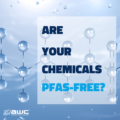There are different types of antiscalants. Some are phosphonate-based, and others are polymer-based. Many are blends to provide synergistic effects of the two chemistries. Antiscalants must be non-toxic, or NSF would not approve them for potable water applications.
Phosphonate-based antiscalants are biodegradable over time; however, they do not meet the description of “readily biodegradable,” where they will degrade in only 28 days. Ultraviolet light increases the rate of degradation as the chemical bonds are broken, and certain types of bacteria produce enzymes that can cleave the bonds.
Synthetic Polymer-based antiscalants are only marginally biodegradable due to their robust chemical bonds, making them resistant to breakdown by natural microorganisms and enzymes. Therefore, the end-user must choose between a partially biodegradable phosphorus-based antiscalant and a non-biodegradable phosphorus-free antiscalant.
Several “green” polymer-based antiscalants have been introduced into the market. While some that are amino-acid based are entirely biodegradable, others are made of plant derivatives and are only partially biodegradable. In reverse osmosis membrane systems, biodegradable antiscalants will contribute to biofouling. After all, the definition of biodegradable is that the chemical will serve as a carbon source for assimilation by microorganisms. Furthermore, our internal testing has revealed that none of the biodegradable antiscalants exhibit scale control efficacy comparable to that of either phosphonates or synthetic polymer-based antiscalants.
When it comes to antiscalants, biodegradability doesn’t always mean sustainability, especially in membrane systems. While biodegradable antiscalants may sound environmentally friendly, they often sacrifice scale control performance and can lead to increased biofouling – this results in operating at higher pressure and therefore higher energy consumption (leading to a larger carbon footprint), more frequent cleaning (leading to a larger water footprint) and even being forced to operate at a lower recovery (larger water footprint). The real sustainability win comes from using highly effective, non-toxic formulations that maximize water recovery, minimize chemical use, and reduce membrane cleaning frequency.
At AWC, we help you make informed decisions that balance performance, environmental responsibility, and operational cost. Contact our technical team to discuss the most effective antiscalants for your system.


